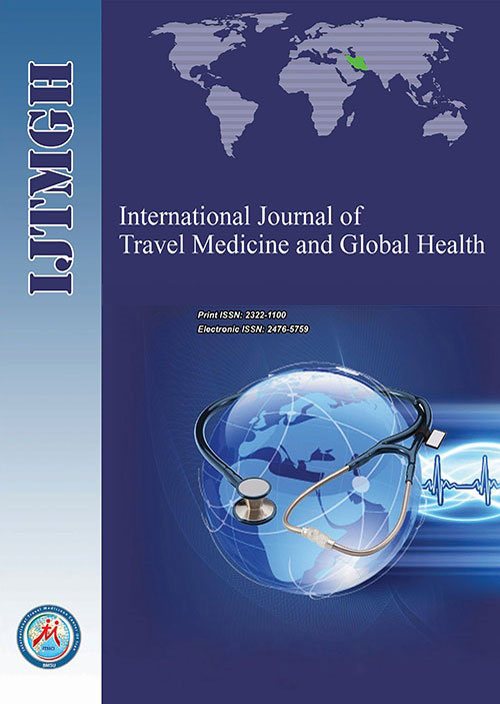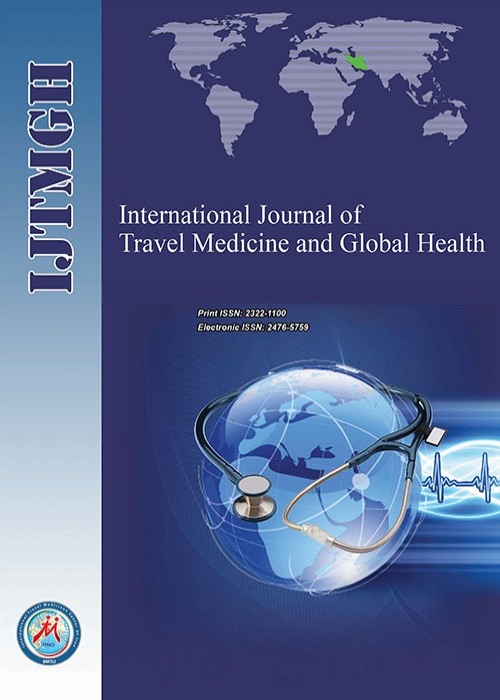فهرست مطالب

International Journal of Travel Medicine and Global Health
Volume:9 Issue: 3, Summer 2021
- تاریخ انتشار: 1400/07/21
- تعداد عناوین: 8
-
-
Pages 102-106
The controversial subject of transplant tourism has been neglected in the travel medicine literature. According to the Declaration of Istanbul, travel for transplantation can be regarded as transplant tourism if it involves organ trafficking and/or commercialised transplantation activities. While no registry of transplant tourism activities exists, published case series point to significant negative clinical outcomes. Adverse outcomes among donors include postoperative depression and anxiety, deterioration in health status, poor surgical wound care, and negative financial effects. Poor perioperative management, inadequate immunosuppression, blood transfusion-associated infections, antibiotic-resistant bacterial infections and invasive fungal infections, are among the most commonly reported complications in transplanted patients. Iran operates a legal and ethically regulated system of rewarded altruistic kidney donation. Travel medicine practitioners have a role to play in protecting the health of intending transplant tourists through targeted pre-travel health counselling and vaccination.
Keywords: Transplantation, Travel, renal transplant, Medical tourism -
Pages 107-112Intoduction
Cardiovascular disease is the leading cause of death among international travellers. We aim to provide an accurate estimate proportion of international travellers who report or are diagnosed with cardiovascular disease while travelling abroad.
MethodsA narrative synthesis of peer-reviewed literature was conducted on cardiovascular disease among international travellers. Healthcare databases and sources of grey literature were searched using pre-defined criteria between February to June 2019. Two reviewers screened all identified studies against protocol and extracted data using a piloted form.
ResultsEight studies were eligible for final analysis. Four studies evaluated data from GeoSentinel Clinic databases. The number of study participants varied across studies from a minimum of 24 to a maximum of 63,076. Between 0.1% to 14% of international travellers reported or were diagnosed with CVD while travelling abroad. Cardiovascular disease was common in male travellers as compared with female travellers. There was a lack of information on pre-existing morbidity, smoking status, obesity in all included studies.
ConclusionThis review provides first-time estimate of the proportion of international travellers with CVD while travelling overseas. Hence, preventive measure to minimize CVD risk such as sufficient exercises during long-distance flights, progressive acclimatization to altitude, wearing of a face-mask in polluted areas, maintaining a healthy lifestyle and nutrition during travelling should be considered. Cardiovascular disease should be an important part of pre-travel health advice.
Keywords: risk factors, Pre-Travel Health Consultation, Overseas -
Pages 113-118Introduction
Since the beginning of COVID-19 epidemic in Iran, several electronic registration systems are created to record the data of infected patients. In this narrative review, it was aimed to investigate the articles that described the COVID-19 electronic registry systems designed and implemented in Iran.
MethodsIn this review, four Electronic databases [Medline (accessed from PubMed), Scopus, Science Direct, and Web of Science] were searched up to June 22, 2020 using specific MeSH terms and related keywords in English language. Considering the titles and abstracts, unrelated studies were excluded. The full texts of the remained studies were evaluated by authors, independently. Then, their findings were assessed and reported.
ResultsFinally 4 articles were enrolled, which introduced four COVID-19 registries. These registries designed and lunched by Isfahan, Shiraz, Tehran and Ilam University of Medical Sciences. They were different in design, the used algorithms for patients' management, recorded data, and methods of quality assurance
ConclusionConsidering the differences between various registry systems designed for COVID-19 in Iran, it is recommended to develop a single web-based registry system by Iran Ministry of Health and Medical Education to register and follow up the patients with COVID-19.
Keywords: Coronavirus, COVID-19, registries, Iran -
Pages 119-123Introduction
Travel Medicine specialty has existed in Latin American for more than 25 years. The creation of Latin American Society of Travel Medicine (SLAMVI) stimulated medical education in this discipline, through research and scientific publications. However, Travel Medicine is practically unknown by Latin Americans.
MethodsLatin Americans (N=9,487) from 9 countries of the region completed an online survey of 10 questions, to determine the knowledge of the population about the existence of this specialty and their attitudes about it.
ResultsDespite the fact that more than 90% of those surveyed knew that to travel to certain countries they had to take certain vaccines, less than 30% had heard of the specialty of Travel Medicine. After knowing the definition and objectives of the specialty more than 90% of the participants considered it important to carry out a pretravel consultation with a specialist.
ConclusionThe lack of knowledge of the specialty is the main barrier for the access of Latin Americans to the Travel Medicine consultation. It is necessary to publicize the specialty, using scientific evidence and taking as an example the worldwide spread of COVID-19 through travelers, make the population aware of the importance of pre and post-travel consultation, as well as the creation of this service in more public hospitals in Latin America.
Keywords: Knowledge, Travel, Vaccines, Immunization -
Pages 124-131Introduction
The COVID-19 pandemic has caused a lot of changes on an individual and societal level. The current study was designed to investigate the impact of the isolation/ social distancing period on people’s sense of Being, Belonging and Becoming in the early stages of the COVID-19 measures.
MethodsA cross sectional survey study design was employed using a researcher-developed questionnaire with items developed based on the Model of Occupational Wholeness to investigate the changes that may have happened to what people have been doing during the COVID-19 measures compared to the time before. A sample of 1206, using snowball sampling, responded to the online questionnaire.
ResultsFindings indicated that participants at the early stage of the COVID-19 pandemic had changed the pattern of their Doings. The change of pattern, which was considered positive, was in relation to people valuing their health, having more time to take care of themselves, and doing activities which they had never had enough time to do before.
ConclusionWhile these findings are not generalizable, they provide some insights into how the post-pandemic lifestyle of many people does not permit doing a lot of activities that could help with their health and well-being. While enforced isolation may have negative consequences, it is also clear that the pre COVID-19 pandemic lifestyle did not fully support healthy living. Reflecting on the COVID-19 lockdown experience provides an opportunity to review what are the essential personal and societal elements for living a healthy life.
Keywords: occupational science, Occupational Therapy, public health, occupational wholeness -
Pages 132-138Introduction
Research shows that Blacks and Hispanics with high socioeconomic status (SES) remain at high risk of cigarette smoking, a pattern called Minorities’ Diminished Returns (MDRs) of SES. In a national sample of American adult smokers, we tested (1) the effects of race, ethnicity, educational attainment, and poverty status on first cigarette flavor in a national sample of American adult smokers, and (2) whether racial and ethnic differences exist in the effects of educational attainment and poverty status on first cigarette flavor.
MethodsThis cross-sectional entered 22,144 ever smoker adults who had participated in the Population Assessment of Tobacco and Health (PATH; 2013), a nationally representative study in the US. Independent variables were race, ethnicity, educational attainment, and poverty status.
ResultsIndividuals with higher education had lower odds of initiating smoking using menthol/mint flavored cigarettes (OR = 0.94) but higher odds of candy/fruit flavored cigarettes (OR = 1.35). Living out of poverty did not associate with initiating smoking using flavored cigarettes. Education showed a weaker (OR = 1.08) protective effect on reducing the odds of initiating smoking using menthol/mint-flavored cigarettes for Hispanics, and living out of poverty had a larger protective effect for Whites than Blacks on the odds of initiating smoking using any flavored cigarettes (OR=1.19). Education had a larger protective effect for Blacks against initiating their smoking using any (OR = 0.88) or menthol/mint (OR = 0.90) flavored cigarettes and education better protected Hispanics than non-Hispanics against initiating smoking using candy/fruit-flavored cigarettes (OR = 0.82).
Keywords: Ethnic Groups, Populations, social determinants, Flavor, tobacco initiation -
Pages 139-145Introduction
Early diagnosis and prognostication of infections such as dengue are crucial for better patient outcome, as they help predict the likelihood of patients developing severe dengue, allowing more comprehensive patient triage and therapeutic interventions. This study aimed to determine clinical, laboratory, and radiological factors predicting prognosis in dengue infection.
MethodsThis prospective observational study included 250 patients seropositive for dengue. They were classified into categories of dengue fever, dengue hemorrhagic fever, and dengue shock syndrome; and evaluated on admission as well as at the end of their hospital course, the latter for factors responsible for progression of dengue to severe dengue. Data were statistically analyzed using R 3.6.1, with P < 0.05 considered statistically significant.
ResultsFinal diagnosis correlated significantly with systolic blood pressure (P=0.004), lowest platelet count (p<0.001), serum glutamic-oxaloacetic transaminase (P=0.001), urine protein (p<0.001), urine red blood cells (p<0.001), pleural effusion (P=0.0064), serositis (p<0.001), vomiting (p <0.001), rash (p <0.001), restlessness (p <0.001), and bleeding manifestations (p<0.001).
ConclusionThe prognosis of dengue is significantly associated with blood pressure, lowest platelet count, serum transaminases, serum creatinine, proteinuria, hematuria, pleural effusion, abdominal pain, persistent vomiting, rash, restlessness, serositis, and bleeding manifestations. Monitoring these parameters is useful for the effective management of dengue.
Keywords: dengue, Platelet count, Serositis, Severe dengue


